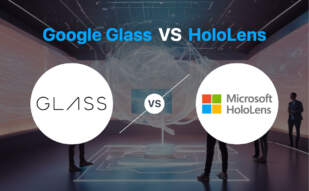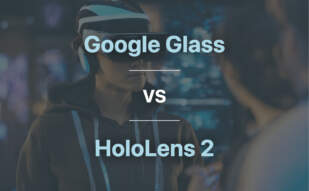Google Glass is a wearable, voice-, motion-controlled Android device providing augmented reality experiences. Originally launched in 2013, the project resumed in 2017 with a focus on professional use. The Glass Enterprise Edition 2 released in 2019 offers features like touchpad, voice recognition, and Google Maps integration.
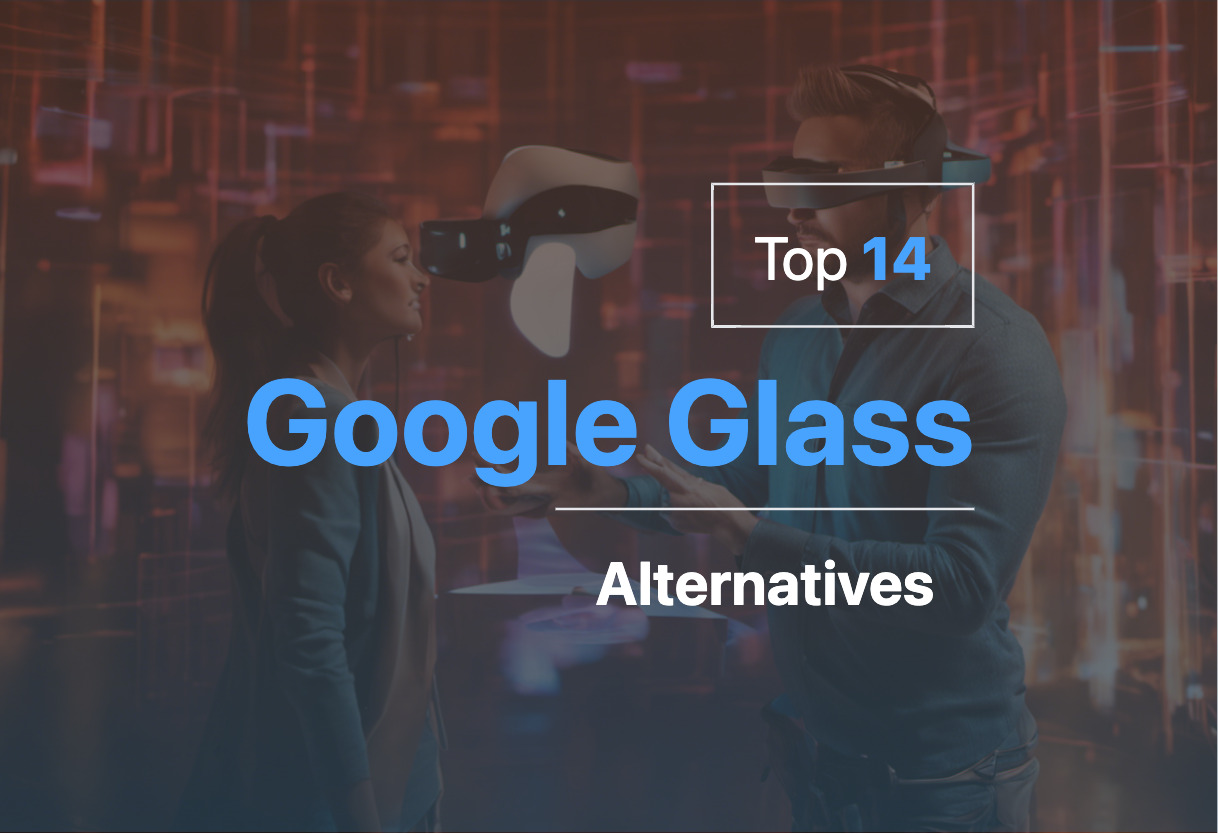
For those exploring alternatives to Google Glass, choices encompass HoloLens, Vision Pro, Oculus, HoloLens 2, Vuzix, Spectacles, Quest, SteamVR, OptiFine, Vive, PlayStation VR, Meta, Quest Pro, Magic Leap.
HoloLens
A stellar product of Microsoft’s foray into the sphere of mixed reality, the HoloLens is an untethered, self-contained holographic device that projects augmented reality. Built on the foundations of increasing productivity across a multitude of sectors—healthcare, manufacturing, and education, to name a few, HoloLens’ real-world applications range from the enterprise-level to education and training programs.
HoloLens Top Features
- Holograms: Advanced 3D visualization enabling efficient planning and simulation.
- Voice control (Cortana): Facilitates hands-free device usability.
- Integration with Microsoft Azure: Seamless cloud connectivity for scalability and data management.
- Biometric recognition and eye tracking: Increases user interactivity and personalizes user experience.
- Spatial audio technology: Enhances overall user immersion within the digital environment.
| Feature | Benefit |
|---|---|
| Hardhat systems integration | Safe, hands-on work across a variety of industries |
| Compatibility with user-friendly apps | Allows integration with SketchUp Viewer, Microsoft Teams, and Autodesk’s FreeForm software |
HoloLens Limitations
- Priced considerably higher than several competitors, placing it out of reach for many potential users.
- While it is untethered, extensive use may lead to discomfort due to the weight distribution of the headset.
- Dependency on cloud may raise issues of data privacy and security.
HoloLens Pricing
The standard version of the HoloLens is priced at $3,500, while the Industrial Edition is available at a slightly higher price point of $4,950.
HoloLens Use Cases
Use case 1: Healthcare
Medical startups like ApoQlar utilize HoloLens to create hologram visualizations to explain surgical procedures to patients, improving patient understanding and engagement. Companies like MEDIVIS also leverage its capabilities for precise and efficient surgery planning.
Use case 2: Manufacturing
Major corporations such as Mercedes-Benz and Lockheed Martin employ HoloLens to facilitate remote assistance and precision in complicated processes such as deep-space vehicle construction.
Use case 3: Education
HoloLens has found an integral place in shaping the future of education. It’s being used for the representation of detailed physiological, anatomical, and pathological models, revolutionizing medical and science education.
Vision Pro
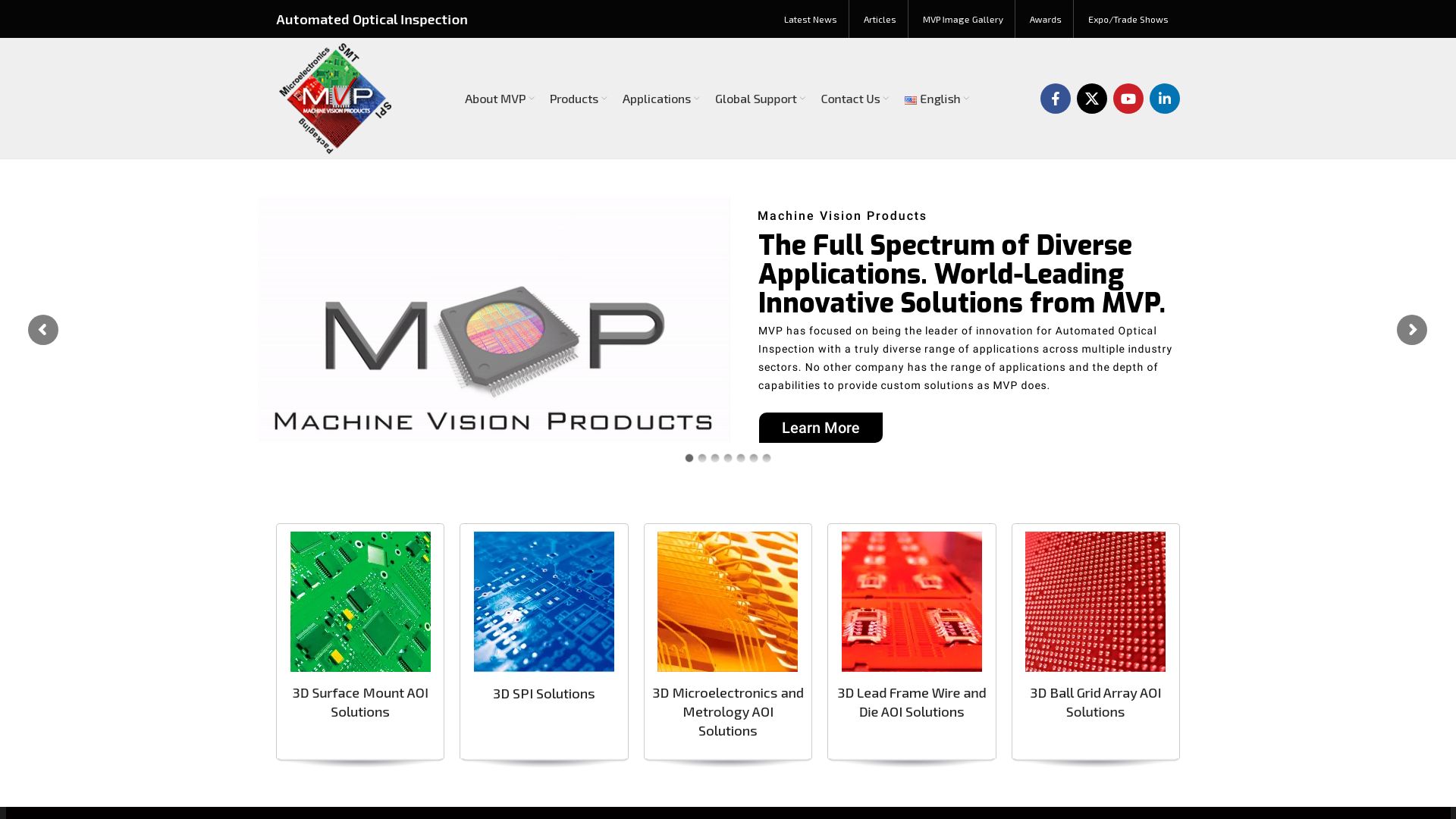
Enter the realm of immersive augmented reality with Vision Pro, the device that beautifully bleeds digital content into physical space. This innovative gadget is slated to revolutionize the tech-ecosystem with its user-friendly controls via voice, eyes, and hands. It’s more than a headset—it’s a leap into a future powered by spatial computing.
Top Features of Vision Pro
- Immersive Spatial Audio: Simulate a real-world audio experience through personalized sound made possible by audio pods.
- 3D Camera: Capture spatial photos and videos to truly memorialize your AR experiences with 12 different cameras.
- The Atomized Workspace: Effectively scale apps to fit within your pocket, ensuring productivity is always at your fingertips.
- visionOS: Apple’s first leap into spatial operating systems. Allows for extensive app integration.
- Vision Pro’s Dual-chip Processor: Offers more complex 3D experiences.
| Feature | Detail |
|---|---|
| 23 Million Pixel micro-OLED Display | An industry-leading resolution that surpasses even 4K quality for a truly immersive visual experience. |
| Precise Eye Tracking | Eliminates the need for controllers, streamline your interaction with the digital world with your eyes alone. |
| External Battery Support | Equipped with an external battery that can keep your device running for up to 2 hours. |
Limitations of Vision Pro
- External Battery Pack Required: Users must manage an additional part which adds to the gadget’s bulk.
- Costly Device: Priced at $3,499, it might be a considerable investment for many tech enthusiasts.
- Dangling Cable: Due to the external battery, the user has to manage the extra cable.
Vision Pro Pricing
Costing $3,499, Vision Pro is a premium device that offers state-of-the-art features to provide a next-gen AR experience worth every penny.
Vision Pro Use Cases
Use Case 1: Collaborative Work
Beneficial for connectivity and collaboration, Vision Pro can revolutionize remote working. It offers real-time hand gestures in your digital avatar, facilitating more interactive virtual meetings.
Use Case 2: Entertainment
Transform any space into a personal theater with Vision Pro. Its immersive spatial audio and superior display quality will redefine the way you perceive digital entertainment.
Use Case 3: Immersive Gaming
The Vision Pro’s superior computing power, precise eye tracking, and immersive audio-visual capabilities make it the perfect device for high-end AR gaming experiences.
PlayStation VR
Riding the wave of virtual Innovation, meet the PlayStation VR (PS VR). This brainchild of Sony Interactive Entertainment, launched in 2016, has taken the tech-world by storm, selling a staggering 5 million units by 2019.
PlayStation VR Top Features
- Compatibility: Works like a charm with PS4 and is backward compatible with PS5.
- Impressive Display: Houses a 5.7-inch OLED panel with 1080p resolution guaranteeing an immersive gaming experience.
- High Tech Tracking: Equipped with 9 positional LEDs for 360-degree head movement tracking.
- Powerful Audio: Features a built-in microphone for in-game strategies and online chat.
- PlayStation VR2: Gearing up for the future with an update revealed at the 2022 CES.
| Features | Details |
|---|---|
| Unique Gaming Experience | Offers VR games along with interactive VR experiences. |
| Room Scale | Performs best in a consistently lit, well-tracked 6-foot by 10-foot play space. |
| Design and ergonomics | Boasts of an aesthetically pleasing and ergonomic design. |
| Effortless Controls | Compatible with DualShock 4 controller, PlayStation Move controllers, or PlayStation VR Aim controller. |
PlayStation VR Limitations
- Performance: The PS VR’s performance can be slightly impaired by room lighting conditions, making dim and no-direct-light environments a necessity.
- Tracking: As much as it is impressive, it does have its shortcomings as compared to HTC Vive.
- Customization: Due to different display properties between PS4 and PS4 Pro versions, some differences may be noticeable to the more discerning users.
- Requirements: It’s compulsory that all games maintain at least 60 frames per second.
PlayStation VR Pricing
For those dreaming of VR immersion, PlayStation VR is a considerably more affordable option than high-end counterparts such as HTC Vive or Oculus Rift. It packs a punch without punching a hole in your wallet.
PlayStation VR Use Cases
Use case 1
Game on! If you’re an enthusiastic gamer on PS4 or PS5, the PlayStation VR transforms your gaming experience into something out of this world. With an array of games consistently getting updated, there’s always a new adventure waiting for you.
Use case 2
Calling all tech-savvy users! Did you know that the PS VR uses existing Move and Camera technology? No more fussing around or additional purchases for you, it’s a plug-and-play experience!
Use case 3
Be the center stage during parties or gatherings! The PlayStation VR can output picture to both the VR headset and the TV simultaneously. With separate VR and TV pictures, you can invite others to join in your virtual reality adventure, offering a communal gaming venture!
Meta
Meta Platforms, Inc., formerly known as Facebook, Inc., is a top American technology conglomerate and one of the Big Five IT tech giants. Operating from their headquarters in Menlo Park, California the company has a diversified portfolio including major social media platforms, advertising, consumer electronics and VR, and aims to move beyond 2D screens to immersive experiences with augmented and virtual reality.
Meta Top Features
- Social media dominance: Provides some of the world’s most popular apps such as Facebook, Instagram, Messenger, and WhatsApp.
- Innovative Services: Creates new ventures like Threads, Horizon Worlds and Ray-Ban Stories to name a few.
- Metaverse: Aims to build an integrated environment linking all services and products into an immersive digital realm.
| Area | Feature |
|---|---|
| Connectivity | Empowers billions of people globally through its social apps. |
| Education | Invests heavily in immersive learning for the next generation of content creators. |
| Business Insight | Offers insights to businesses through its platform. |
Meta Limitations
- Lack of full transparency on user data usage.
- Various controversies such as the Cambridge Analytica scandal and whistleblower cases have raised concerns about its management practices.
Meta Use Cases
Use case 1 – Social Connection
With its social media dominance, Meta provides an integral platform for users worldwide to connect, share, and communicate.
Use case 2 – Business Insights
For businesses, Meta provides valuable insights and opportunities to connect with customers in new ways.
Use case 3 – Education and Future Tech
Its heavy investments in immersive learning make it a potential game-changer for the schooling and professional training sectors.
Quest Pro
Introducing the Quest Pro, a top-notch AR/VR headset intended for professional users due to its advanced features and higher price range.
Quest Pro Top Features
- Features 5 cameras for unparalleled vision fidelity.
- Employs a Snapdragon XR2+ processor, 50% stronger than Quest 2.
- Boasts a resolution of 1,920 x 1,800 pixels per eye.
- Offers improved comfort with optional light blocker accessory.
- Pair of redesigned, light, and less cumbersome motion controllers.
| Feature | Description |
|---|---|
| Design | Sleek, black, glossy front panel with a professional look. |
| Charging Cradle | Incorporates USB-C port, cable, and wall adapter, with recesses for charging both the headset and controllers. |
| Standby Mode | Always-on display for uninterrupted experience. |
Quest Pro Limitations
- Higher cost, making it more suitable for professionals.
- Unpadded headset may cause discomfort.
- Limited consumer-focused software utilizing Quest Pro upgrades.
Quest Pro Pricing
The Quest Pro price stands at $1499.99, roughly three times the cost of Meta Quest 2. This underscores its superior specs and professional target audience.
Quest Pro Use Cases
Use case 1
Quest Pro is perfect for enterprise users seeking to integrate AR/VR into their workflows, thanks to its powerful processor and high resolution.
Use case 2
Its higher cost makes Quest Pro a great choice for professionals needing a mix of virtual and real-world applications.
Use case 3
For users aged 10 and above, Quest Pro can be leveraged for mature-rated apps offering high graphic performance.
Magic Leap
An American tech giant, Magic Leap was founded in 2010 by Rony Abovitz. The company, valued at $2 billion as of 2021, is known for their head-mounted AR displays, Magic Leap One and Magic Leap 2.
Magic Leap Top Features
- Light-field chip deploying silicon photonics, offering superior visual quality.
- Partnership with powerhouse corporations like AT&T and Lucasfilm to provide unique AR experiences.
- AI assistant, Mica, introduced in 2018 for richer user interaction.
| AR Hardware | Key Features |
|---|---|
| Magic Leap One | 1st headset; online launch in June 2018 |
| Magic Leap 2 | Touted as industry’s smallest and lightest device; primarily targeted at business use |
Magic Leap Limitations
- Company restructuring in 2020 significantly affected its financial stability and workforce.
- Despite attracting significant funding, company valuation plummeted by 93% within 6 months in 2020.
Magic Leap Use Cases
Use case 1
Magic Leap’s integration of AI and AR offers an immersive interactive experience, making it ideal for gaming and creative experiences.
Use case 2
Its partnership with AT&T & Lucasfilm extends its reach in producing captivating content for the entertainment industry.
Use case 3
Magic Leap 2, being the smallest and lightest device in the industry, is perfectly suited for enterprise use, contributing to more engaging business presentations and training.
Oculus
Exploding onto the AR/VR scene with the aim of reviving the VR industry, Oculus introduced the Oculus Rift, a VR headset line making immersive experiences accessible to many.
Oculus Top Features
- Unparalleled field of view, providing more than 90 degrees horizontal, double the FOV of previous VR devices.
- An impressive resolution of 1280×800, effectively offering 640×800 per eye.
- Advancement in technology, with the use of three-axis gyros, accelerometers, and magnetometers for absolute head orientation tracking without drift.
- Oculus Rift S, an upgraded version released in 2019, saw software compatibility with the predecessor and its successor, Oculus Quest.
| Year | Model | Vital Features |
|---|---|---|
| 2013 | Oculus Rift DK1 | 90 degrees horizontal and 110 degrees vertical stereoscopic 3D view. |
| 2016 | Oculus Rift CV1 | First public model, features improvements from prototypes & Crystal Cove |
| 2019 | Oculus Rift S | Replaces CV1, carries forward compatible software library |
Oculus Limitations
- Oculus Rift S, the last of the Oculus Rift line, was discontinued in April 2021.
- Still expensive to some users despite efforts to make VR accessible.
Oculus Use Cases
Use case 1: Gaming
With Oculus’ emphasis on immersive experiences, it enhanced virtual gaming, achieving a more realistic scenario than traditional gaming methods. DK1’s 90 degrees horizontal and 110 degrees vertical stereoscopic 3D view embodied true innovation.
Use case 2: Professional training
In domains like medicine, military, and aviation, Oculus devices provided a risk-free, immersive learning environment. The hardware’s accurate head orientation tracking enabled realistic simulation scenarios.
Use case 3: Virtual tourism
Oculus’ VR headsets allowed users to virtually explore remote locations, bringing the world closer. The high resolution and generous field of view created a strikingly realistic experience.
HoloLens 2
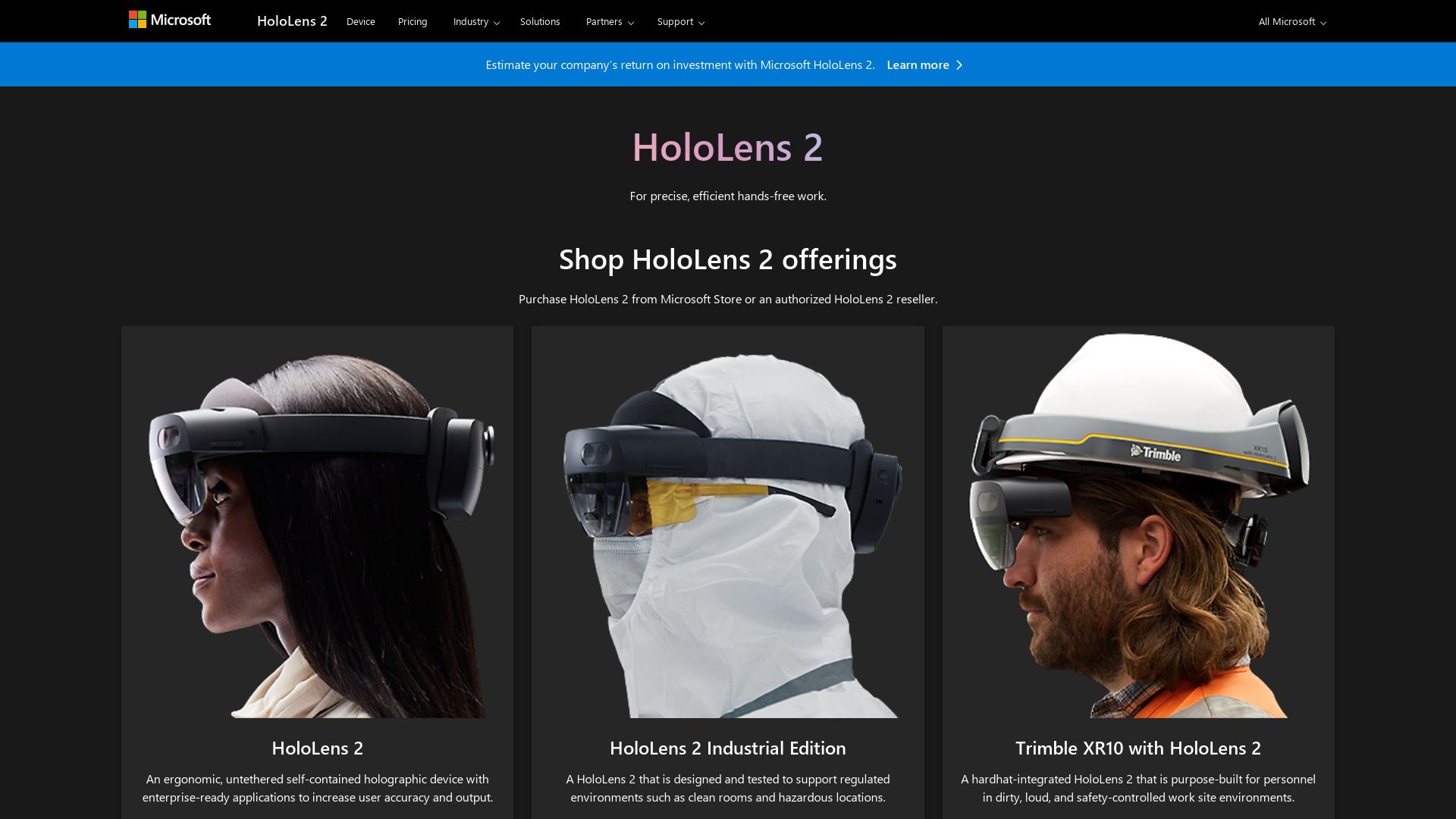
Setting its sights on the enterprise market with a newfound emphasis on productivity and education, the HoloLens 2 from Microsoft has leapfrogged into the augmented reality landscape. Diverging from the path oft-chosen by gaming and tech enthusiasts, the HoloLens 2 is part of Microsoft’s vision of leveraging AR technology for training, operations and learning purposes.
Top HoloLens 2 Features
- Transparent lenses integrated onto a visor for deep AR immersion.
- State-of-the-art 1-MP Time-of-Flight depth sensor, amplifying hand-tracking and anchoring capabilities.
- Infrared cameras offering crisp eye-tracking.
- Nifty 5-mic array for communication and voice commands.
- 84% resolution upgrade over its predecessor from 1280×720 to 2048×1080 pixels.
- Advanced Qualcomm Snapdragon 850 processor, coupled with 4 GB DDR4 RAM for seamless performance.
- Fine-tuned form fitting elite headstraps and adjustable IPD lenses.
| Key Features | Details |
|---|---|
| In-built Spatial Sound | Supports a comprehensive communication matrix. |
| Battery Life | Offers approximately 3-hour longevity, extending to 2 hours under intense use. |
| Collaborative Platform | Microsoft Mesh for shared AR experiences. |
HoloLens 2 Limitations
- Determined skewing away from gaming and entertainment applications.
- Higher price range making it a fit mainly for enterprise level requirements.
- Weight of 566 grams; approximately 70g heavier than popular VR headsets like the Oculus Quest 2.
HoloLens 2 Pricing
Groundbreaking technology comes with its price tag. The HoloLens 2 is available for purchase at a price of $3,500.
HoloLens 2 Use Cases
Enterprise Training and Development
HoloLens 2’s immense processing power, combined with spatial sound and 3D content manipulation, makes it an excellent asset for on-the-job training and professional development.
Operations and Field Work
With its substantial spatial awareness upgrades validated by the US Army, HoloLens 2 can be beneficial for performing complex operational tasks on field.
Education
Leveraging the Microsoft Mesh platform for shared AR experiences, HoloLens 2 can be a compelling education tool, enabling immersive learning and interactive sessions.
Vuzix

Based in Rochester, NY, Vuzix is at the leading edge of the AR glasses market, utilizing waveguide technology in their products. Presently, their flagship Blade AR glasses and the newer, enhanced Blade 2 are available to consumers.
Vuzix Top Features
- Optic clarity driven by a custom micro display engine and monocular waveguide optics.
- Hands-free access to data; ideal for the deskless workforce.
- Integrating popular virtual assistants such as Google Assistant and Amazon’s Alexa.
- Product features have won multiple CES awards for innovation.
- Received the DARPA’s next generation heads up display design beneficiary status for STAR 1200, the first augmented reality glasses.
| Product | Key Feature |
|---|---|
| Blade 2 | Improved memory management and enhanced WiFi features |
| Ultralite Glasses | Lightweight, power-efficient design with a two-day run time |
Vuzix Limitations
- Blade AR Glasses serve as a phone accessory rather than a complete AR device.
- High price point at $999.99 for Blade AR glasses and Blade 2.
Vuzix Pricing
The Vuzix Blade AR glasses, as well as the newer Blade 2 model, are priced at $999.99.
Vuzix Use Cases
Use case 1
Vuzix products excel in workplace settings, especially for frontline workers requiring hands-free access to data and remote expertise.
Use case 2
For the general consumer market, convenient features such as notifications, app usage and virtual assistants are conveniently available at a glance.
Use case 3
Military defense can benefit from the company’s experience with products like Tac-Eye, bringing crucial information to the user’s field of view.
Spectacles

An unsurpassed synthesis of centuries of technological developments, Spectacles, represents the acme of eyewear innovation. From 13th-century Italy’s inception of wearable glasses to the present day, Spectacles builds on a rich heritage to provide optimal eye care solutions.
Top Features of Spectacles
- Aspheric Lenses: Ensuring crisper vision, reducing distortion and lighter in weight than standard spherical lenses.
- High-index Plastic Lenses: Transition from traditional glass or crystal lenses fosters a significant weight reduction, making eyeglasses thinner.
- Polycarbonate Lenses: Boasting a more impact-resistant, thinner and lighter design, ensuring maximum durability.
- Anti-reflective Coatings: Decreasing light reflection for improved vision quality.
| Trivex Lenses | Better than polycarbonate for rimless or drill-mount frames due to higher quality optics. |
| Bifocal Corrections | An age-old technology, originally innovated by Benjamin Franklin, continues to be employed in 21st-century eyeglass technology. |
| Fashion-Driven Designs | Evolved significantly since the 20th century, catering to style-conscious consumers. |
Limitations of Spectacles
- While plastic lenses are less breakable, they may not offer the same clarity as traditional glass or crystal lenses.
- The focus on fashionable designs may compromise practical functionality for visually challenged individuals.
- High-tech lenses like Trivex may be more expensive than conventional options.
Spectacles Use Cases
Renaissance Scholars
Early Renaissance scholars, often depicted wearing glasses in their artwork, attest to the profound utility and success of the Spectacles’ precursors. Equipped to offer advanced vision correction, Spectacles leverage this legacy to assist today’s intellectual community.
Modern Vision Correction
In an age where digital screens are ubiquitous, Spectacles serves as the saviour, protecting from harmful radiations and easing the strain with anti-reflective coatings and high-index lenses.
Fashion Statement
Echoing the trend of glasses worn as a status symbol during Renaissance, Spectacles’ modern designs serve to complement the user’s style, making them a fashion essential.
Quest
Quest is a VR headset by Oculus, under the umbrella of Facebook’s Meta, aimed at propelling VR into mainstream appeal. Long absolutely independent of phones or PCs, the fourth in Oculus’s consumer line was launched on May 21, 2019, and remains at the forefront of standalone VR technology.
Quest Top Features
- Standalone design – No need to connect to a phone or PC.
- Viewing Experience – Benefits from a higher resolution screen than the original Rift’s, at 1600 x 1440 pixels per eye.
- Game Options – Compatible with 500+ VR games, providing access to a vast library of immersive experiences.
- Dual Hand Controllers – Supports hand tracking for certain games and includes redesigned Touch Plus controllers.
- Wireless Design – Offers convenience of use with a battery life lasting between two to three hours.
| Feature | Description |
|---|---|
| Tracking | Includes four wide-angle tracking cameras. |
| Advanced VR Experiences | Optional accessory cable for PC tethering enhances graphical performance. |
| Storage | Available in 64GB or 128GB storage options, with the option to upgrade to 256GB for an additional cost. |
Quest Limitations
- Snapdragon 835 chipset – Reliance on the 2017 Qualcomm Snapdragon 835 mobile chipset may limit performance.
- Battery Life – At two to three hours, it may not support extended use.
Quest Pricing
The Quest VR headset was introduced at a price of $399 with the Quest 3 slated for launch in the fall of 2023, retailing at $499.99 for the 128GB variant. An increased storage model will be available for an additional cost.
Quest Use Cases
Use Case 1: Gaming
With support for popular gaming experiences like Beat Saber, The Climb, Robo Recall and 500+ other games, Quest serves as an essential device for mainstream VR gaming.
Use Case 2: VR Exploration
The standalone wireless design of Quest provides a seamless VR exploration experience, untethered by wires or the need for a gaming PC.
Use Case 3: High-definition Visual Experiences
With a high-resolution screen and a 120Hz refresh rate mode, Quest offers a high fidelity visual experience, making it suitable for applications demanding visual detail and fluidity.
SteamVR

Dive into an immersive virtual universe with SteamVR. Born from the innovative minds at Valve, this powerful runtime comes to life when a VR headset is connected to your PC. Offering compatibility with various HMDs, including its own Vive and other devices such as the Rift, SteamVR paves your path to a holistic VR journey.
SteamVR Top Features
- Offers a comprehensive 360-degree full room VR experience.
- Facilitates device management capabilities for firmware updates and device pairings.
- Supports in-app purchases with a microtransactions API, extending the realm of possibilities.
- Presents SteamVR Home, a dynamic launching pad for VR experiences.
- Enhances engagement with SteamVR Collectibles – 3D items rewarded to players based on game ownership and playtime.
- Empowers additional functionalities with the creation of overlay applications.
| Peripheral Device | Description |
|---|---|
| CyberShoes | Enhance natural walking movements in VR, compatible with multiple headsets including Valve Index, Meta Quest Pro, Oculus Rift&S, and HTC Vive. |
| Cyberchair | Offers 360-degree freedom and connects via Bluetooth and PC Radio Frequency. |
| Cybercarpet | Designed for antistatic quality to accommodate safe gaming movement. |
SteamVR Limitations
- In 2022, users reported compatibility issues between SteamVR and Meta Quest 3 when using air link.
- Requires higher-end system requirements, including OS: Windows 7 SP1, Windows 8.1 or later, Windows 10, Processor: Intel Core i5-4590/AMD FX 8350 equivalent or better, and Graphics: NVIDIA GeForce GTX 970, AMD Radeon R9 290 equivalent or better.
SteamVR Use Cases
Use case 1
For avid gamers, SteamVR provides an overwhelming VR environment that enhances the gaming experience with software for 3D environment creation.
Use case 2
For developers, SteamVR’s microtransactions API supports the structuring of in-app purchases, giving artistic freedom and a new revenue stream.
Use case 3
For corporate settings, SteamVR serves as a standalone powerhouse, not requiring distribution with Steam, giving users design freedom and control.
OptiFine
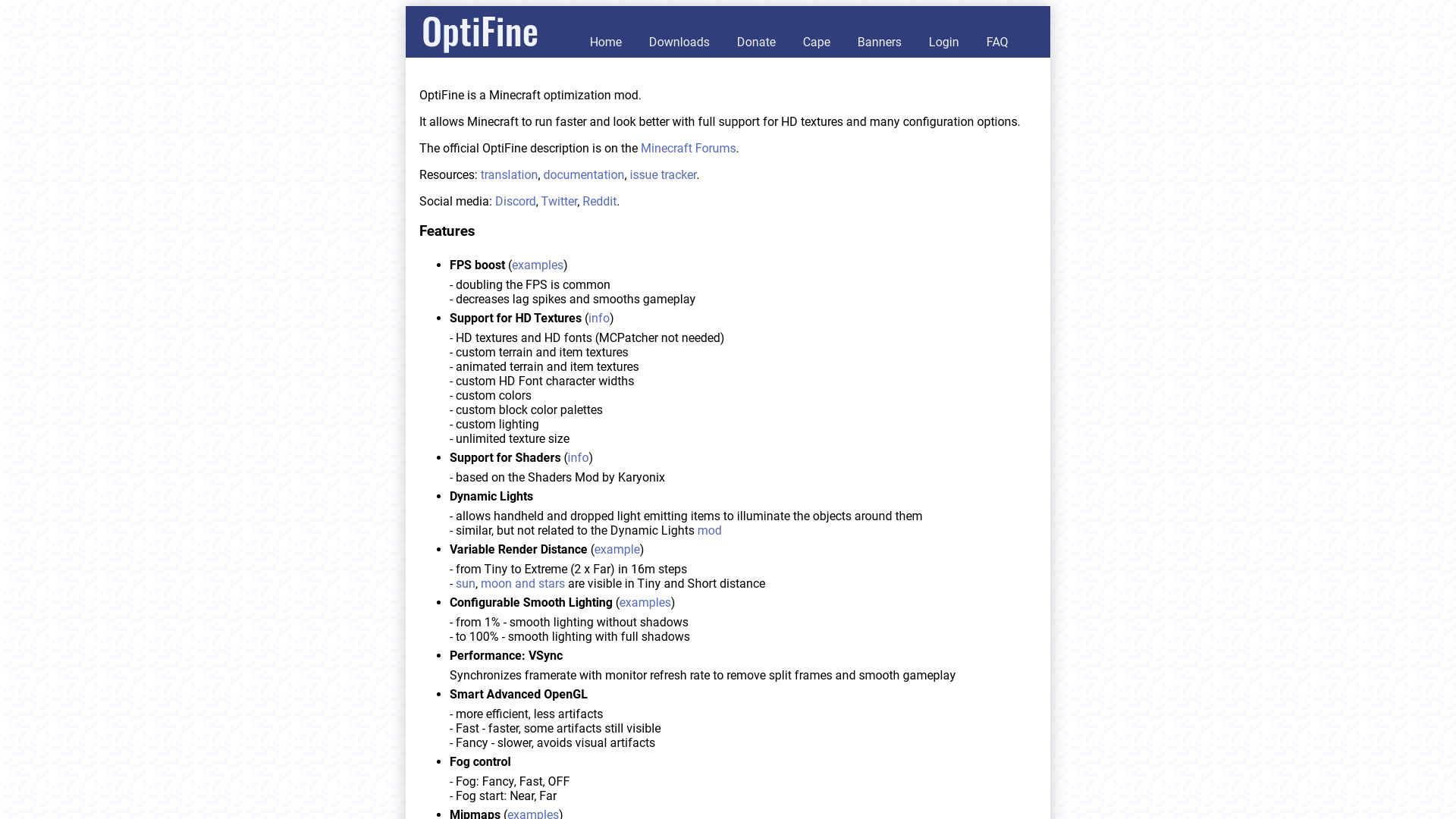
An independent mod for Minecraft launched in 2012, OptiFine is renowned for its impressive abilities to boost game speed, enhance aesthetics and offer immense customization.
Top Features of OptiFine
- Speed Boost: Doubles FPS and minimizes lag, optimizing both GPU and CPU usage.
- HD textures: Delivers high-definition textures, enabling infinite textures size.
- Customizability: Facilitates configurable animations and fast texture pack switching.
- Advanced Support: Ensures support for shaders and offers advanced OpenGL.
| Feature | Details |
|---|---|
| Dynamic Lights | Illuminates objects by using handheld/dropped light-emitting items. |
| Variable Render Distance & Configurable Smooth Lighting | Enhances the experience by extending visibility and adjusting lighting conditions. |
| Fog Control and Mipmaps | Controls the appearance of fog and improves the scene visualization of distant objects. |
Limitations of OptiFine
No software is without its downsides and OptiFine is no different. Please refer back to the company summary for this part, as limitations are not provided.
OptiFine Pricing
OptiFine is a free mod, allowing players to experience an optimized game without any expense.
OptiFine Use Cases
Use Case 1: Game Aesthetics
With its HD shaders and texture packs like the Martha Stewart Resource Pack, OptiFine can be used to dramatically enhance the visual appeal of your Minecraft game.
Use Case 2: Performance
For gamers plagued by lag and subpar performance, OptiFine’s Smooth FPS and Smooth Input optimize gameplay for a much more fluid experience.
Use Case 3: Modding
Aspiring modders can leverage OptiFine’s features to create unique game modifications, such as combining Minecraft and Pokemon or locating ores and minerals with Xray Ultimate.
Vive
An illustrious suite of VR hardware, Vive, is developed by HTC and Valve. Offering high-end VR experiences, it is powered by external computers or game consoles and boasts a variety of impressive features.
Vive Top Features
- Motion Tracking: Immersive, real-time motion tracking.
- High resolution: Offers premium-quality graphics through high-resolution screens.
- Freedom of Movement: Laser tracking system within a 15 x 15-foot room for maximized interaction.
- Controllers: Vive’s specially designed controllers bring precision to gaming experiences.
- Content Library: Native access to HTC Vive’s exclusive content library, inclusive of bonus games.
- High-Resolution 5K screens: Perfect for gamers seeking advanced specs.
| Upgrade Pick | Benefit |
|---|---|
| HTC Vive Pro 2 | Features the highest resolution for optimum visual experience. |
| Valve Index Controllers | Complement Vive Pro 2 with comfort and pinpoint tracking precision. |
| Game Library | Diverse, including Beat Saber, Half-Life: Alyx, and others. |
Vive Downsides
- The requirement of a VR-ready PC could entail an additional cost of around $1,000.
- Conventional wand-style controllers can feel awkward to some users, recommending the use of Valve Index Controllers instead.
- Vive requires high-end computers for exploiting its max potentiality – an added investment.
Vive Pricing
Pre-launch price for Vive is estimated to be around $799, with potential additional cost from requisite high-end PC setup estimated at around $1,000.
Vive Use Cases
Use Case 1: Gaming Enthusiasts
Vive is ideal for gamers seeking a premium VR experience. With its high-powered motion tracking, expansive room-scale tracking, and a large, diverse game library, it furthers the gaming experience to an unprecedented extent.
Use Case 2: Tech Buffs
For the tech-agnostic user, the Vive offers a taste of the cutting edge of VR technology. Its high-resolution screens, laser tracking and hefty content library make it the perfect gadget to dive into the future.
Use Case 3: Gaming Developers
Game developers can benefit from the sophistication and variety of Vive’s controller offerings, which provide a myriad of opportunities for innovative game design and playing experiences.
Logan Bellbrook
Content writer @ Aircada with a knack for nature & AR/VR/XR. Blogging the intersection of tech & terrain.



